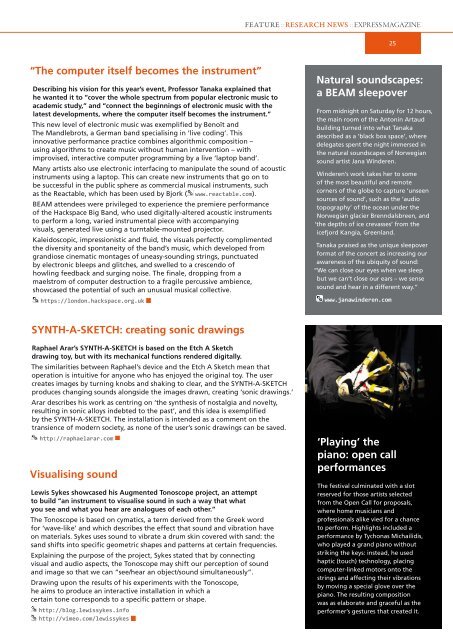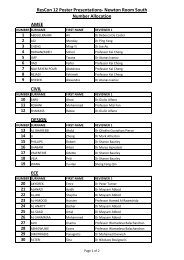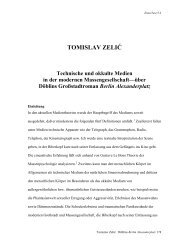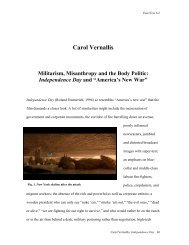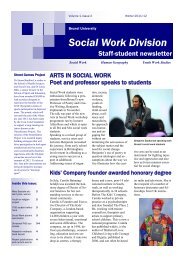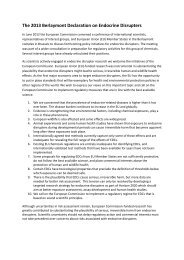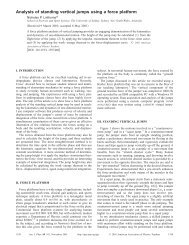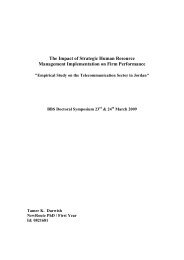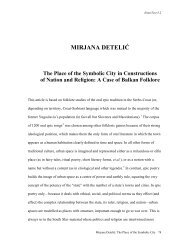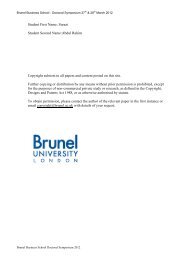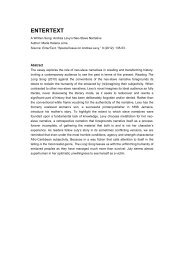Issue 16 Autumn 2012 - Brunel University
Issue 16 Autumn 2012 - Brunel University
Issue 16 Autumn 2012 - Brunel University
Create successful ePaper yourself
Turn your PDF publications into a flip-book with our unique Google optimized e-Paper software.
“The computer itself becomes the instrument”<br />
Describing his vision for this year’s event, professor Tanaka explained that<br />
he wanted it to “cover the whole spectrum from popular electronic music to<br />
academic study,” and “connect the beginnings of electronic music with the<br />
latest developments, where the computer itself becomes the instrument.”<br />
This new level of electronic music was exemplified by Benoît and<br />
The Mandlebrots, a German band specialising in ‘live coding’. This<br />
innovative performance practice combines algorithmic composition –<br />
using algorithms to create music without human intervention – with<br />
improvised, interactive computer programming by a live ‘laptop band’.<br />
Many artists also use electronic interfacing to manipulate the sound of acoustic<br />
instruments using a laptop. This can create new instruments that go on to<br />
be successful in the public sphere as commercial musical instruments, such<br />
as the Reactable, which has been used by Bjork ( www.reactable.com).<br />
BEAM attendees were privileged to experience the premiere performance<br />
of the Hackspace Big Band, who used digitally-altered acoustic instruments<br />
to perform a long, varied instrumental piece with accompanying<br />
visuals, generated live using a turntable-mounted projector.<br />
Kaleidoscopic, impressionistic and fluid, the visuals perfectly complimented<br />
the diversity and spontaneity of the band’s music, which developed from<br />
grandiose cinematic montages of uneasy-sounding strings, punctuated<br />
by electronic bleeps and glitches, and swelled to a crescendo of<br />
howling feedback and surging noise. The finale, dropping from a<br />
maelstrom of computer destruction to a fragile percussive ambience,<br />
showcased the potential of such an unusual musical collective.<br />
https://london.hackspace.org.uk<br />
SYNTH-A-SKETCH: creating sonic drawings<br />
Raphael Arar’s SYNTH-A-SKETCH is based on the Etch A Sketch<br />
drawing toy, but with its mechanical functions rendered digitally.<br />
The similarities between Raphael’s device and the Etch A Sketch mean that<br />
operation is intuitive for anyone who has enjoyed the original toy. The user<br />
creates images by turning knobs and shaking to clear, and the SYNTH-A-SKETCH<br />
produces changing sounds alongside the images drawn, creating ‘sonic drawings.’<br />
Arar describes his work as centring on ‘the synthesis of nostalgia and novelty,<br />
resulting in sonic alloys indebted to the past’, and this idea is exemplified<br />
by the SYNTH-A-SKETCH. The installation is intended as a comment on the<br />
transience of modern society, as none of the user’s sonic drawings can be saved.<br />
http://raphaelarar.com<br />
Visualising sound<br />
Lewis Sykes showcased his Augmented Tonoscope project, an attempt<br />
to build “an instrument to visualise sound in such a way that what<br />
you see and what you hear are analogues of each other.”<br />
The Tonoscope is based on cymatics, a term derived from the Greek word<br />
for ‘wave-like’ and which describes the effect that sound and vibration have<br />
on materials. Sykes uses sound to vibrate a drum skin covered with sand: the<br />
sand shifts into specific geometric shapes and patterns at certain frequencies.<br />
Explaining the purpose of the project, Sykes stated that by connecting<br />
visual and audio aspects, the Tonoscope may shift our perception of sound<br />
and image so that we can “see/hear an object/sound simultaneously”.<br />
Drawing upon the results of his experiments with the Tonoscope,<br />
he aims to produce an interactive installation in which a<br />
certain tone corresponds to a specific pattern or shape.<br />
http://blog.lewissykes.info<br />
http://vimeo.com/lewissykes<br />
FeATUre :: reseArCH NeWs :: eXPRess MAGAZINe<br />
25<br />
Natural soundscapes:<br />
a BEAM sleepover<br />
From midnight on Saturday for 12 hours,<br />
the main room of the Antonin Artaud<br />
building turned into what Tanaka<br />
described as a ‘black box space’, where<br />
delegates spent the night immersed in<br />
the natural soundscapes of Norwegian<br />
sound artist Jana Winderen.<br />
Winderen’s work takes her to some<br />
of the most beautiful and remote<br />
corners of the globe to capture ‘unseen<br />
sources of sound’, such as the ‘audio<br />
topography’ of the ocean under the<br />
Norwegian glacier Brenndalsbreen, and<br />
‘the depths of ice crevasses’ from the<br />
icefjord Kangia, Greenland.<br />
Tanaka praised as the unique sleepover<br />
format of the concert as increasing our<br />
awareness of the ubiquity of sound:<br />
“We can close our eyes when we sleep<br />
but we can’t close our ears – we sense<br />
sound and hear in a different way.”<br />
www.janawinderen.com<br />
‘playing’ the<br />
piano: open call<br />
performances<br />
The festival culminated with a slot<br />
reserved for those artists selected<br />
from the Open Call for proposals,<br />
where home musicians and<br />
professionals alike vied for a chance<br />
to perform. Highlights included a<br />
performance by Tychonas Michailidis,<br />
who played a grand piano without<br />
striking the keys: instead, he used<br />
haptic (touch) technology, placing<br />
computer-linked motors onto the<br />
strings and affecting their vibrations<br />
by moving a special glove over the<br />
piano. The resulting composition<br />
was as elaborate and graceful as the<br />
performer’s gestures that created it.


